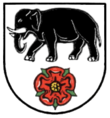Elephant (heraldic animal)

The elephant is rare in European heraldry as a heraldic animal . Deggingen ( Swabian Alb ) makes reference to the Counts of Helfenstein , like the nearby cakes and Oppingen shown . In the non-European countries, the heraldic elephant is very popular. In Africa and Asia in particular , it appears more frequently in coats of arms . Examples are the coat of arms of Ivory Coast , the coat of arms of the Central African Republic and the coat of arms of Thailand .

As a common figure , like the common, well-known heraldic animals, it is subject to the rules of heraldry. As a rule, it is depicted in silver, and a special tincture of reinforcement is not in use. Ears, proboscis and tusks are only shown very decoratively. His characteristics, he is considered strong and gentle, should be reflected as far as possible in the coat of arms. The tusks are always shown in pairs.
The elephant can appear in the coat of arms , but also in the upper coat of arms . It functions as a shield holder , for example, in the coat of arms of Swaziland and the coat of arms of the Republic of the Congo . It is the same in the English city of Oxford . There the elephant can be seen holding a sign.
Evidence for an early appearance in the coat of arms are pictures (in the shield) in Grünenberg's coat of arms book . It is not unlikely that the elephant became known through Italian heraldry . So led Tomaso di Savoia already in 1234 one in the seal. In Germany one in the coat of arms of the Counts of Helfenstein became known as a mockery of "Helfanten" as early as the 14th century (1340). In 1396 an elephant head was listed as a jewel in the coat of arms of the Overstolz family .
The whole elephant or just the front part are common when using the coat of arms. He is speaking in the coat of arms of the Republic of Ivory Coast .
In the coat of arms of the Kingdom of Siam ( coat of arms of Thailand ) a white elephant was heraldic animal until 1910. It was replaced by the Garuda .
A coat of arms with the front view of a white elephant on a red background was planned for the German colony of Cameroon . However, due to the First World War , the coat of arms was not used.
Curious events have put the elephant on the coat of arms in Niederroßla .
See also
Individual evidence
- ↑ a b Gert Oswald : Lexicon Heraldik. VEB Bibliographische Institut, Leipzig 1984.
- ↑ Otto Titan von Hefner : Basic Saeze der Wappenkunst. Bauer & Raspe, Nuremberg 1855, p. 22 .
